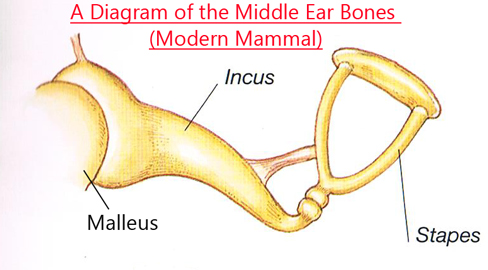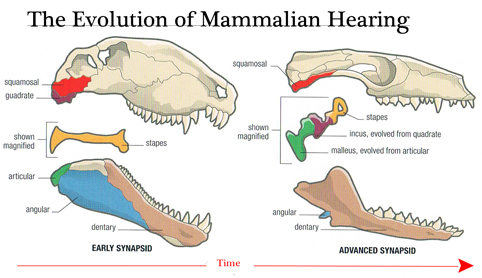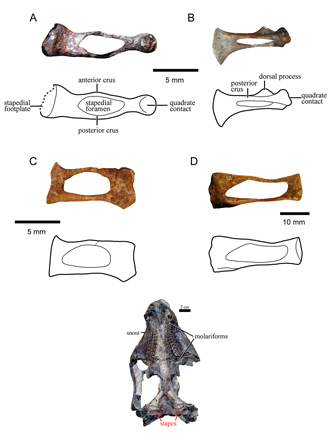The First Detailed Analysis of the Stapes In Triassic Cynodonts
The smallest bone in the human body and how it evolved has been the subject of a major research project conducted by scientists at the University of Witwatersrand (Johannesburg, South Africa). That small bone is called the stapes and it forms part of the three bones of the middle ear, the malleus, incus and the stapes which together are known as the ossicles. All modern mammals possess these three bones, which are also called the hammer, anvil and the stirrup, these names relate to their shapes, as the stapes for example, resembles a stirrup, the support for a rider’s foot.
Mammalian Evolution
A Diagram Showing the Shape of a Extant Mammal’s Stapes
Picture credit: Everything Dinosaur
University of Witwatersand Research
A team of scientists from the University of Witwatersand’s Evolutionary Studies Institute which includes Dr Leandro Gaetano and Professor Fernando Abdala have completed the first detailed comparative analysis of ancient ear bones of Triassic cynodonts, ancient synapsids that are ancestral to the Mammalia. Until this study was carried out, it had long been thought that the stapes showed no differences between species. However, in this new research, published in the academic journal PLoS One, the researchers map variations in the morphology of this bone, even amongst animals of the same species.
Commenting on their findings, Dr Gaetano stated:
“No one has really paid attention to this small bone before. In studying this ear bone of Triassic Cynodonts, the forerunners of mammals, including humans, over the past two years we now start to see these differences.”
The Hearing Mechanism of Reptiles
Reptiles have a different hearing mechanism when compared to mammals. As the synapsid clade evolved and modern mammals came about, they evolved more sophisticated and sensitive hearing. Scientists believe that the three middle ear bones gave the early mammals, which were probably nocturnal, an improved ability to detect high-frequency sounds – useful if you spent your waking hours in the dark and you relied on your hearing to detect prey as well as to sense danger. Bones in the reptilian jaw, the articular (lower jaw) and the quadrate (upper jaw) evolved into the middle ear bones, connecting to the stapes and forming the ossicles.
Mammalian Middle Ear (Evolution)
Picture credit: Everything Dinosaur
Embryo Studies and Transitory Fossils
Embryo studies and the discovery of a number of transitory fossils have provided evidence for this, however, in this study it was the stapes as found in many Triassic cynodonts which lived between 250 and 22o million years ago, that was central to this new analysis. The stapes is the only ear bone in mammalian ancestors, the evolution of the middle ear configuration as found in modern Mammalia had not yet occurred when the animals featured in this study were alive.
The Variation in the Shape of the Stapes of Triassic Cynodonts
Picture credit: Witwatersrand University
The picture above shows morphological variation in the stapes of Triassic gomphodont cynodonts.
A, Diademodon; B, Trirachodon; C and D, Massetognathus.
Below is the ventral view of the skull of a cynodont showing the position of the stapes.
Dr Gaetano explained:
“Few contributions studied the stapes in cynodonts and it has been historically regarded as a conservative element, showing no difference among species. Surprisingly, we discovered that there are noticeable variations in the morphology of this bone, even within representatives of the same species.
This research is helping to unravel a mystery surrounding the origins of the middle ear bones and their configuration. Professor Abdala suggests that the sound waves in cynodonts were transmitted to the inner ear from an eardrum at the posterior part of the lower jaw through the stapes and quadrate bones. The research is on-going, utilising the extensive Permian and Triassic vertebrate fossil record found in South Africa (the biota of the Karoo basin).
The Next Stage of the Research Project
The next stage is to try to calculate the impact on hearing ability of the differently shaped stapes bones that the team have identified. In addition, the scientists will focus on ontogenic changes (changes in the shape of the stapes from the youngest to the oldest animal in one extinct species).
For replicas and models of ancient reptiles and other prehistoric creatures: CollectA Deluxe Prehistoric Life Figures.








